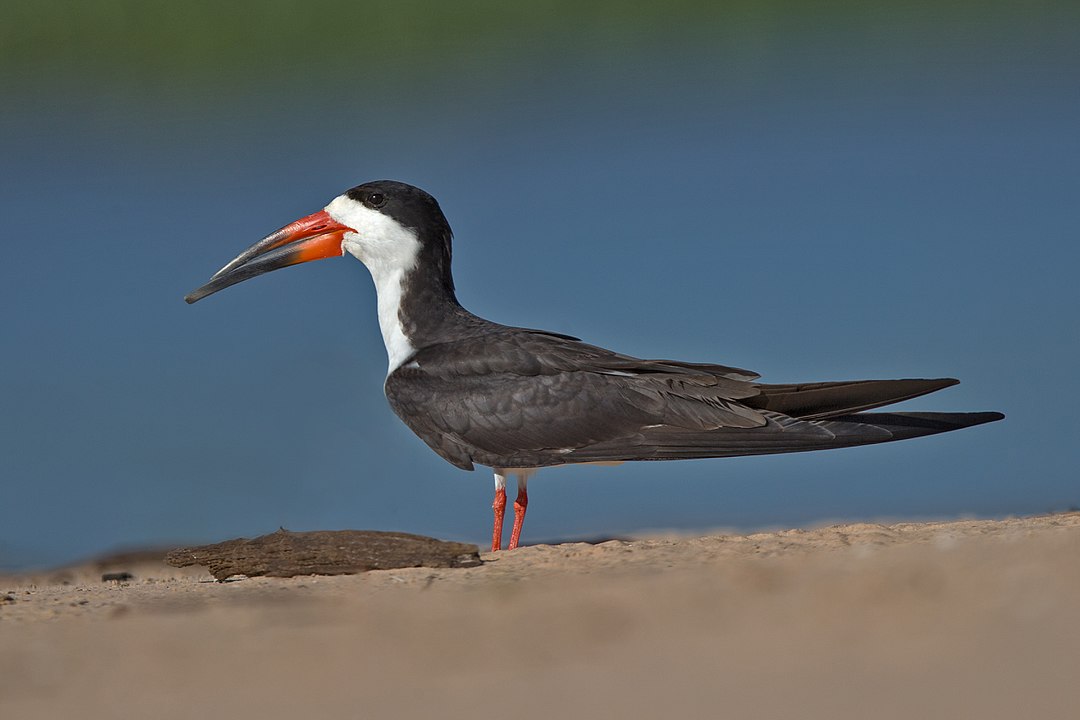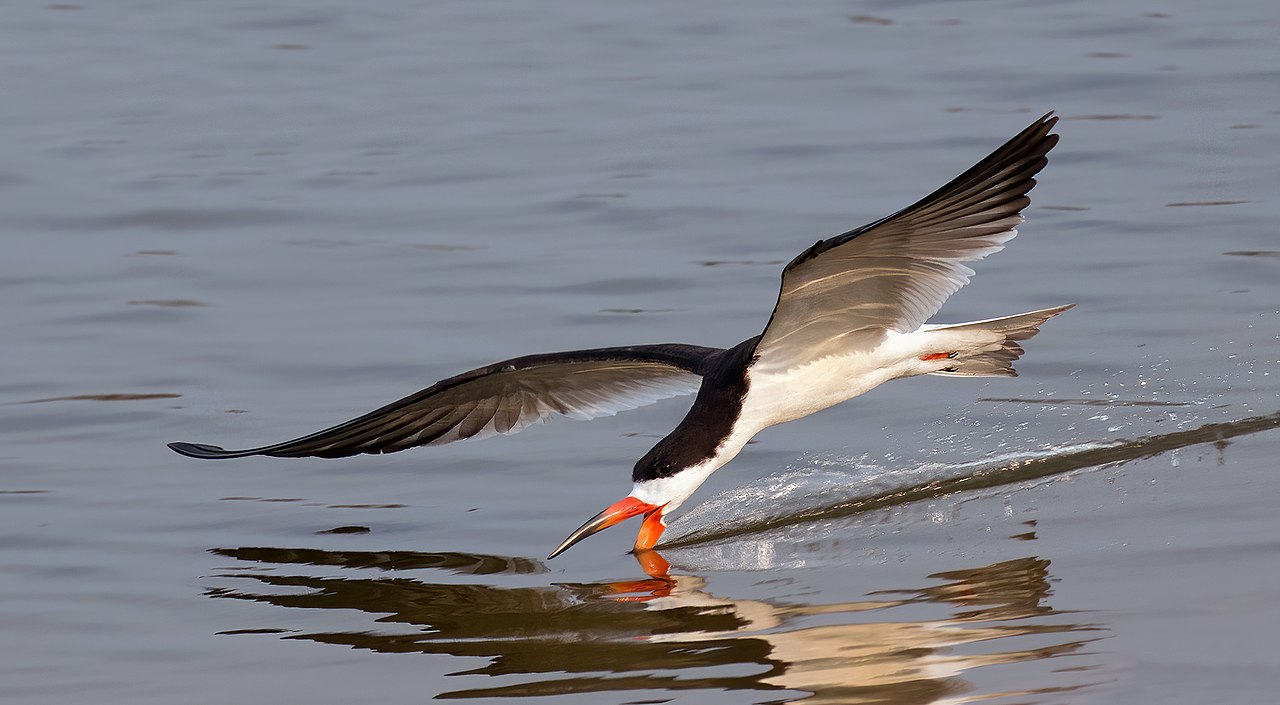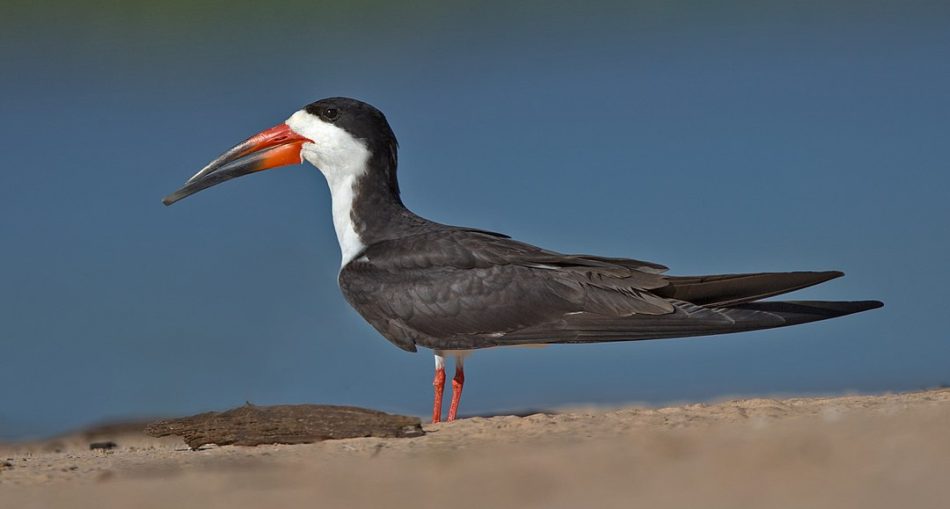With lithe beats of their wings, the Black Skimmers skim the surface of the water with open beaks, fishing for their next meal. These birds spend their entire lives on beaches, breeding, nesting and feeding in the same area. In Guyana, these birds frequent our sandy, coastal areas and sometimes the mudflats of mangrove reserves. They have been spotted in places like Mahaicony, East Coast of Demerara, and the Kingston Jetty in Georgetown. The scientific name of the Black Skimmer is Rynchops niger and it is the largest species of its genus. Rynchops, the name of the genus is Greek for rhunkhos meaning ‘bill’ and ops, which means ‘face’. Niger is Latin for black, most likely referring to their colour. There are three (3) subspecies of the Black Skimmer species; R. n. intercedens, R. n. cinerascens, and the R. n. niger. Black Skimmers are native to both South America, and North America as well as the tropical and subtropical Pacific coasts. They can be found in the Caribbean, to which they migrate from the north during the cold of winter. Black Skimmers in South American countries like Guyana and Brazil, however, do not migrate but may move due to flooding.

A Black Skimmer lounging on a beach – Photo By Andreas Trepte – Own work, CC BY-SA 4.0, https://commons.wikimedia.org/w/index.php?curid=43432734
Description Of The Black Skimmer
The Black Skimmer is about forty to fifty (40–50) cm or sixteen to twenty (16–20) inches in length. Its wingspan roughly measures about one hundred and seven to one hundred and twenty-seven (107–127) cm. While the birds have a weight of about two hundred and twelve to four hundred and forty-seven (212-447) grams, the males are typically on the heavier side. Black Skimmers have elongated bills, the lower of which is thinner. Their beaks red at the basal half, and the remaining beak is black. At hatching, the mandibles are equal but during the fledging stage, they quickly grow uneven. As opposed to most bird species, the Black Skimmer has a vertical pupil, like cats and a dark brown iris. Their legs are red and darker in colour than their bills. The adults capable of breeding have a plumage that consists of a black crown and nape. In addition, the upper body is black while the underparts and forehead are white. Their upper wings are black, tails and rumps are dark grey and lined in white. Depending on the region, the underwing may be white or a murky grey. Unlike breeding adults, the upperparts of non-breeding adults are paler and brown in colour with a white nape. The immature birds have brown upperparts and the feathers tips and fringes are lined in white, which is more noticeable. The underparts, forehead and underwings of non-breeding adults are white.
Scientific Classification Of The Black Skimmer
- Kingdom: Animalia
- Phylum: Chordata
- Class: Aves
- Order: Charadriiformes
- Family: Laridae
- Genus: Rynchops
- Species: R. niger
Habitat Of The Black Skimmer
This species of bird live in coastal areas, particularly on sand beaches, islands and lagoons. However, some North American colonies live in giant lakes. Nesting Black Skimmer can be found in open sandy areas, gravel or shell bars with little vegetation.
Diet Of The Black Skimmer
Like flamingoes and many other birds that frequent the coast, the Black Skimmer diet consists primarily of seafood; small fish, crustaceans and molluscs. They eat fish like flounder, silversides, herring, sea trout, mullet, Spanish mackerel, and snapper. They are also known to eat like shrimp and blue crabs. Black Skimmers normally feed in large flocks, during the day or night. During their hunting, the birds fly close to water, open their beaks and skim the surface of the water for their food.

The Black Skimmer – Photo By Charles J Sharp – Own work, from Sharp Photography, sharpphotography, CC BY-SA 4.0, https://commons.wikimedia.org/w/index.php?curid=43958377
Behaviour Of The Black Skimmer
Black Skimmers spend their days lounging about on sandbars in rivers and on coasts. At rest, the birds will often lay on the sand-even head and bill to give their neck a break. When it’s time for feeding, the colonies head to the water. They sometimes forage according to tides, especially in tidal areas, usually after low tide and shortly before high tide but this may vary. Black Skimmers breed in loose groups, right on the sandbanks and have a unique call, sounding like ‘kak-kak-kak’.
Sometimes the birds nap in flocks and remain standing as they do. Those on the edges will tuck their bills into the wing on the outer side, on the lookout for any approaching threats. Male Black Skimmers tend to be protective of their territory, especially nesting grounds. They protect their females and warn others with threatening displays of head tosses and intimidates by looking down with tails held up very high.
Reproduction Of The Black Skimmer
The Black Skimmers birds are very active during the nesting seasons and have interesting displays. During courtship, the males would usually gift a fish to the female. New pairs fly behind each other about the nesting areas and parade with outstretched necks and bills held high. During mating, the males usually put on a grand display of wing-flagging. Black Skimmers produces a clutch of three to seven (3-7) eggs which are incubated by both parents. The eggs are either bluish or blotched in a dark colour. Their chicks leave their nests shortly after hatching and lay in the nest, shaded from the heat by their parents. Sometimes they make their own depressions in the sand. Chicks are fed only in the day.
About The Black Skimmer
The Black Skimmer is a graceful bird known for its ‘kak-kak-kak’ call and love for sandy areas, where they lounge about until feeding or nesting time. Black Skimmers in the tropical area do not migrate, unlike those in the colder areas. However, many coastal habitats have changed, and as a result, the distribution of the Black Skimmers has been limited in their typical range. The next time you’re at the beach, keep an eye out for the Black Skimmer. If you’re lucky you may be able to catch them during feeding time and observe their perky nature.
Article Reference
- https://en.wikipedia.org/wiki/Black_skimmer
- https://www.allaboutbirds.org/guide/Black_Skimmer/lifehistory#:~:text=Black%20Skimmers%20forage%20mostly%20when,when%20the%20crabs%20are%20molting).
- https://www.kesterclarke.net/galleries/birds-of-guyana/gulls-terns-skimmers/black-skimmer/







